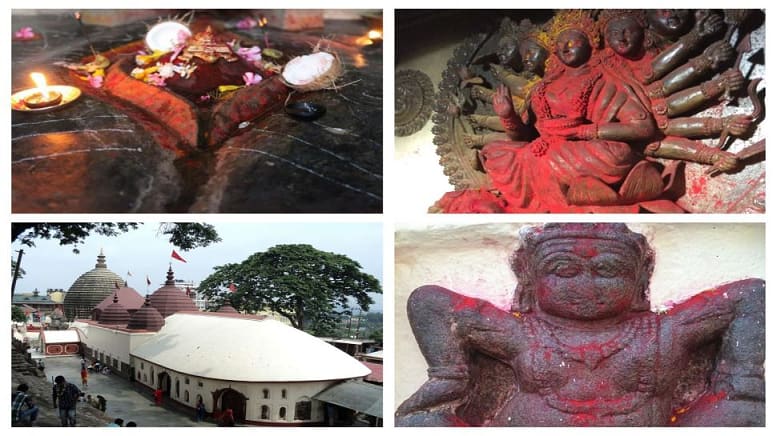Religious and Spiritual Landscape of Assam: History, Culture, Temples, and Rituals
Explore Assam and its rich history of religion.
Assam, the gateway to Northeast India, is a land of rich spiritual traditions, diverse religious practices, and centuries-old temples. The state's religious identity is deeply rooted in Hinduism, Shaktism, Vaishnavism, tribal animistic traditions, Islam, and Buddhism. With ancient temples, sacred rituals, and a vibrant culture of devotion, Assam stands as an important spiritual hub in India.
This article explores the religious history, temples, rituals, traditions, and devotee culture in Assam while tracing the origins and evolution of its spiritual landscape.
Historical and Religious Origins of Assam
The religious history of Assam dates back to the early Vedic period and the times of ancient Indian civilization. The region finds mention in the Mahabharata, Kalika Purana, Yogini Tantra, and numerous Buddhist and Jain scriptures.
Ancient Period (Before 10th Century CE)
Assam's religious history began with animistic and nature-worshipping traditions followed by indigenous tribes like the Bodos, Kacharis, Dimasas, and Ahoms. The region saw the development of Hinduism, Shaktism, and Shaivism through early Aryan influence. Kamakhya Temple, one of the Shakti Peethas, finds mention in texts dating back to this period. The Kalika Purana, written in the 10th century CE, describes Assam as "Pragjyotisha," meaning the Eastern City of Astrology, and "Kamarupa," the land where Kamadeva (the god of love) regained his form after being incinerated by Lord Shiva’s wrath.Medieval Period (10th – 17th Century CE)
This era saw the rise of the Ahom dynasty (1228–1826), who were followers of Tai animist beliefs but later assimilated into Hindu traditions. During the 15th and 16th centuries, Srimanta Sankardeva, a revered saint, social reformer, and Vaishnavite guru, introduced the Bhakti movement in Assam. He established Ekasarana Dharma, a monotheistic form of Vaishnavism that transformed Assamese religious and cultural life. Neo-Vaishnavite Satras (monastic institutions) emerged as centers of devotion, literature, music, and dance.Colonial and Modern Period (18th Century – Present)
With British colonial rule in the 19th century, Christian missionary activities began, but Hinduism, Vaishnavism, and tribal traditions remained dominant. Assam’s religious diversity expanded further with the migration of Muslim communities, Sikhs, and Christians. Today, Assam remains a confluence of Hinduism, Islam, Buddhism, Christianity, and tribal spiritualism.
Major Temples and Religious Sites in Assam
Assam is home to numerous ancient temples dedicated to various deities, particularly Shakti, Shiva, Vishnu, and local folk deities. Some of the most significant religious sites include:
1. Kamakhya Temple (Guwahati)
Significance: One of the 51 Shakti Peethas in Hinduism, Kamakhya Temple is dedicated to Goddess Kamakhya, an embodiment of Shakti.
Origin & Mythology: According to legend, this is where the yoni (womb) of Goddess Sati fell after Lord Vishnu dismembered her body using his Sudarshan Chakra.
Festival & Rituals: The Ambubachi Mela (celebrating the annual menstruation cycle of the goddess) and Durga Puja are grandly observed.
Architecture: Built in the Nilachal style, the temple features a dome-shaped shikhara and intricate stone carvings.
2. Umananda Temple (Peacock Island, Guwahati)
Dedicated to: Lord Shiva (Umananda, a form of Bhairava)
Significance: Located on the world’s smallest river island in the Brahmaputra River, the temple is associated with Lord Shiva’s penance.
Festivals: Maha Shivaratri is celebrated with great fervor.
3. Navagraha Temple (Guwahati)
Dedicated to: The nine celestial bodies (Navagrahas) in Hindu astrology.
Significance: This temple is a major astrological center and attracts devotees seeking planetary blessings.
4. Sukreswar Temple (Guwahati)
Dedicated to: Lord Shiva
Significance: Located on the banks of the Brahmaputra River, this temple houses one of the largest Shiva lingas in India.
5. Hajo - Hayagriva Madhava Temple (Hajo)
Dedicated to: Lord Vishnu in the form of Hayagriva (the horse-headed incarnation).
Significance: This site is sacred to both Hindus and Buddhists, as it is believed to be the place where Lord Buddha attained Nirvana.
Festival: The Doul Utsav (Holi) is widely celebrated.
6. Sivasagar Shiva Temples (Sivasagar)
Includes: Sivadol, Vishnudol, and Devidol temples
Significance: Built by the Ahom kings, these temples stand as grand symbols of Assam’s Shaivite culture.
7. Mahabhairab Temple (Tezpur)
Dedicated to: Lord Shiva
Significance: Said to be established by King Bana of the Mahabharata era.
Religious Rituals and Devotee Culture in Assam
Hindu and Vaishnavite Rituals
Naam Kirtan (Congregational Chanting): Introduced by Srimanta Sankardeva, Naam-Kirtan is an essential part of Assamese Vaishnavism.
Xattriya Rituals: Performed in Satras (monastic institutions), these include devotional songs (Borgeets), dances, and prayers.
Puja Offerings: Devotees offer flowers, milk, and sweets in temples like Kamakhya and Umananda.
Ambubachi Mela: A major tantric ritual celebrating the fertility aspect of Goddess Kamakhya.
Durga Puja & Bihu Festivals: These are integral to Assamese Hindu culture.
Tribal Religious Practices
Animism & Shamanism: Many tribal communities worship spirits, ancestors, and nature.
Bihu Festival: Originally a fertility ritual celebrated by farmers.
Bathou Puja: The Bodo community worships Bathou (the supreme deity) using a Siju (Euphorbia) plant.
Buddhist Practices
Karmapa & Theravada Influence: Assam’s Buddhist monks follow the Tibetan and Theravada traditions.
Meditation Centers: Located in Hajo and Tawang (near Assam).
Famous Religious Festivals of Assam
1. Ambubachi Mela (Kamakhya Temple)
Celebrates the menstrual cycle of Goddess Kamakhya, symbolizing Mother Earth’s fertility.
2. Majuli Raas Festival
A grand re-enactment of Lord Krishna’s Raas Leela.
3. Bihu (Magh, Rongali, Kati)
Though primarily an agrarian festival, Bihu involves temple visits and devotional songs.
4. Durga Puja
Grand celebrations across Assam with processions, prayers, and community feasts.
5. Me-Dam-Me-Phi (Ahom Ancestor Worship)
Honors the departed souls of Ahom ancestors.
Religious Tourism and Pilgrimage Culture
Assam attracts thousands of devotees and religious tourists annually. The Kamakhya Temple, Hajo, and Sivasagar circuits are popular among Hindu pilgrims. Vaishnavite Satras in Majuli (world’s largest river island) are major spiritual centers.
Devotee Experience: Pilgrims visit Assam’s temples seeking divine blessings, participating in religious festivals, and experiencing Assam’s devotional traditions.
Travel Facilities: Assam Tourism promotes religious circuits with connectivity through rail, road, and air.
Best Time to Visit: October to April (for festivals and pleasant weather).
Religious Tourism and Pilgrimage Circuits in Assam
Assam is a significant destination for religious tourism, attracting thousands of pilgrims and spiritual seekers every year. The temples, Satras, and ancient sites offer a deep spiritual experience. Assam’s pilgrimage circuits are designed to provide devotees with a well-structured itinerary covering the most sacred places in the region.
1. The Kamakhya Circuit (Shakti and Shaivism Pilgrimage)
The Kamakhya Circuit is the most significant pilgrimage route in Assam, centered around Shaktism, Shaivism, and astrology. It includes some of the most powerful temples in Assam.
Major Sites in the Kamakhya Circuit
Kamakhya Temple (Guwahati)
One of the 51 Shakti Peethas.
Dedicated to Goddess Kamakhya, representing the feminine divine power.
Known for Ambubachi Mela, celebrating the goddess’s menstruation cycle, symbolizing fertility.
Architecture: Nilachal style with domed shikhara.
Umananda Temple (Peacock Island, Guwahati)
Dedicated to Lord Shiva in his Bhairava form.
Located on Peacock Island in the Brahmaputra River.
Mythological connection to Shiva’s penance at this location.
Can be reached via a boat ride from Guwahati.
Basistha Temple (Guwahati)
Associated with Rishi Basistha, one of the seven great sages (Saptarishis).
Situated in a serene forested area on the outskirts of Guwahati.
The temple is near a hermitage (ashram) and a sacred river flowing through rocky terrains.
Navagraha Temple (Guwahati)
A powerful astrological temple dedicated to the nine celestial bodies (Navagrahas).
Considered one of the best places for astrological remedies and planetary worship.
Devotees visit to seek blessings for good fortune, planetary alignment, and relief from astrological afflictions.
Best Time to Visit the Kamakhya Circuit:
Ambubachi Mela (June) for Tantric worshippers and Shakti devotees.
Durga Puja and Navaratri (September-October).
Maha Shivaratri (February-March) at Umananda and Basistha temples.
2. Majuli Satra Circuit (Vaishnavite Pilgrimage)
Majuli, the world’s largest river island, is the cultural and spiritual heart of Assamese Vaishnavism. It is home to historic Vaishnavite Satras (monasteries) founded by Srimanta Sankardeva, the 15th-century saint and social reformer.
Major Satras in the Majuli Circuit
Auniati Satra
One of the largest and most influential Satras in Assam.
Famous for traditional Sattriya dance, music, and Vaishnavite scriptures.
Houses ancient manuscripts, relics, and antique Assamese artifacts.
Dakhinpat Satra
Known for hosting the grand Raas Leela Festival, a dramatic depiction of Lord Krishna’s divine play.
A center for spiritual discussions, arts, and Vaishnavite philosophy.
Attracts thousands of pilgrims during Raas Festival in November.
Kamalabari Satra
A center of Vaishnavite education and Sanskrit learning.
Well-known for its contribution to Sattriya dance and theater.
The monks (bhakats) practice austere lifestyles devoted to bhakti.
Pilgrim Experience in Majuli Satras
Devotees participate in Naam Kirtan (congregational chanting) and spiritual discourses.
Traditional Sattriya dance performances narrating Lord Krishna’s life.
Pilgrims take holy dips in the Brahmaputra River, which is believed to cleanse sins.
Best Time to Visit Majuli Satra Circuit:
Majuli Raas Festival (November) for Vaishnavite pilgrims.
Bihu (April and January) when Satras organize cultural events.
Winter months (October to February) for comfortable travel.
3. Sivasagar Ahom Temple Circuit (Shaiva and Ahom Heritage Pilgrimage)
Sivasagar, the ancient capital of the Ahom kingdom, is home to majestic temples and royal monuments. The Ahoms, who ruled Assam for over 600 years (1228–1826), were followers of Shaivism and Shaktism, and they built some of the grandest temples in the region.
Major Temples in the Sivasagar Circuit
Sivadol (Shiva Temple)
One of the tallest Shiva temples in India (over 104 feet).
Built by Ahom Queen Ambika in 1734 CE.
The temple hosts grand Maha Shivaratri celebrations.
Vishnudol (Vishnu Temple)
Dedicated to Lord Vishnu.
Built in Ahom architectural style with detailed sculptures.
Devotees visit during Vaikuntha Ekadashi and Janmashtami.
Devidol (Devi Temple)
Dedicated to Goddess Durga.
Celebrates Durga Puja with grand processions.
Kareng Ghar and Talatal Ghar (Ahom Royal Palaces)
The Kareng Ghar was the royal palace of the Ahom kings.
The Talatal Ghar has an underground escape route, showcasing advanced medieval architecture.
Pilgrim Experience in Sivasagar
Pilgrims worship Lord Shiva, Vishnu, and Goddess Durga in grand temples.
Explore Ahom heritage sites to understand Assam’s historical and spiritual legacy.
Participate in Maha Shivaratri celebrations at Sivadol, attracting thousands of devotees.
Best Time to Visit Sivasagar Circuit:
Maha Shivaratri (February-March) at Sivadol.
Durga Puja (September-October) at Devidol.
Winter months (November to February) for comfortable exploration.
Other Notable Pilgrimage Destinations in Assam
1. Hajo Pilgrimage Circuit (Hindu & Buddhist Pilgrimage)
Hayagriva Madhava Temple: Sacred to both Hindus and Buddhists.
Madan Kamdev Temple: A lesser-known but ancient Shakti temple.
2. Tezpur and Bhalukpong Circuit
Mahabhairab Temple (Tezpur): One of Assam’s most sacred Shiva temples.
Bhairabi Temple (Tezpur): Dedicated to Goddess Bhairabi (Durga).
Travel Tips for Pilgrims Visiting Assam
Best Travel Season: October to March (cool weather, festival season).
Transport:
Guwahati is the main entry point (connected by air, rail, and road).
Majuli is accessible via ferry from Jorhat.
Sivasagar is well-connected by road and train.
Accommodation:
Dharamshalas (pilgrim lodges) are available near major temples.
Budget and luxury hotels are available in Guwahati, Majuli, and Sivasagar.
Local Cuisine:
Prasadam from temples (simple vegetarian meals).
Assamese specialties like Mah-prasad (offered in Vaishnavite Satras).
Assam’s religious landscape is a blend of Hinduism, Vaishnavism, Shaktism, animistic tribal beliefs, Islam, and Buddhism. With ancient temples, grand rituals, and deep-rooted traditions, Assam remains a vital spiritual and religious center in India. Whether through the sacred chants at Kamakhya, the serene Vaishnavite Satras, or the vibrant tribal rituals, Assam’s religious diversity is a testament to its rich cultural heritage.
Assam’s religious heritage is deeply rooted in Hinduism, Shaktism, Vaishnavism, Shaivism, and tribal spiritualism. The temples of Kamakhya, Umananda, and Hayagriva Madhava, along with Vaishnavite Satras, define its spiritual identity. Festivals, devotional music, dance, and sacred rituals make Assam a center of divine reverence.
From the mystical chants of Borgeets to the Tantric rites of Kamakhya, Assam continues to uphold its legacy as a spiritual and religious heartland of India.



